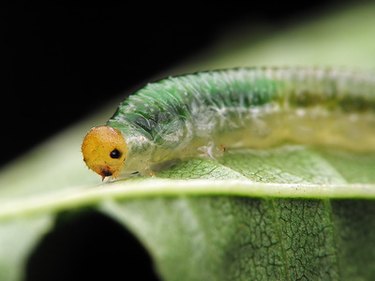
Caterpillars are larvae that go through several stages, often changing color as they mature and, after pupation, becoming butterflies or moths. While they mature, caterpillars feed on plant leaves. Avocados, grapes and other fruits and vegetables grow well in Southern California's soil and climate, giving caterpillars many crops and gardens to choose from.
Omnivorous Looper
Video of the Day
The Omnivorous looper, known by the scientific name Sabulodes aegrotata, is also called avocado looper or just looper. When they are young, these caterpillars are just .006 inches long and a pale yellow. They feed on a leaf's surface, leaving a brown membrane. As they mature, their color changes to mostly yellow, pale green, or pink and they grow longer, ranging from 2 to 2.5 inches long, with a gold-colored head. Once they are older, dark brown, black, green, and orange lines appear along their sides. A fully grown omnivorous looper can eat an entire leaf in a day. After pupation, the omnivorous loopers transforms into moths that are mostly tan or orange on top with a black band along their wings.
Video of the Day
Amorbia
The Amorbia is in the Tortricidae family. It primarily feeds on avocado, which gives it its other name, the Western Avocado Leafroller. These caterpillars are a yellow-green when young and turn a darker green as they mature. Older caterpillars have a distinct mark, a short black horizontal line on the side of their thorax, which distinguishes them from other avocado caterpillars. Young larvae often web leaves together with silk and chew on them. Mature caterpillars can eat the whole leaf, starting at the center or along the edges.
Orange tortrix
The Orange tortrix feeds on citrus, strawberry, and grape crops. A part of the Tortricidae family, the orange ortrix has the scientific name of Argyrotaenia citrana. The caterpillars have a brown or straw-colored head, with a section behind the head called a prothoracic plate. Their body color varies and can be dark grey, green, tan, or straw-colored. After pupation, these caterpillars turn into orange or tan moths with shading across the wings. The orange tortrix's natural predators include assassin bugs, birds, damsel bugs, lacewings, and pirate bugs.
- University of California Integrated Pest Management: UC Management Guidelines for Omnivorous Looper on Avocado
- University of California Integrated Pest Management: UC Management Guidelines for Amorbia (Western Avocado Leafroller) on Avocado
- University of California Integrated Pest Management: UC Management Guidelines for Orange Tortrix on Avocado